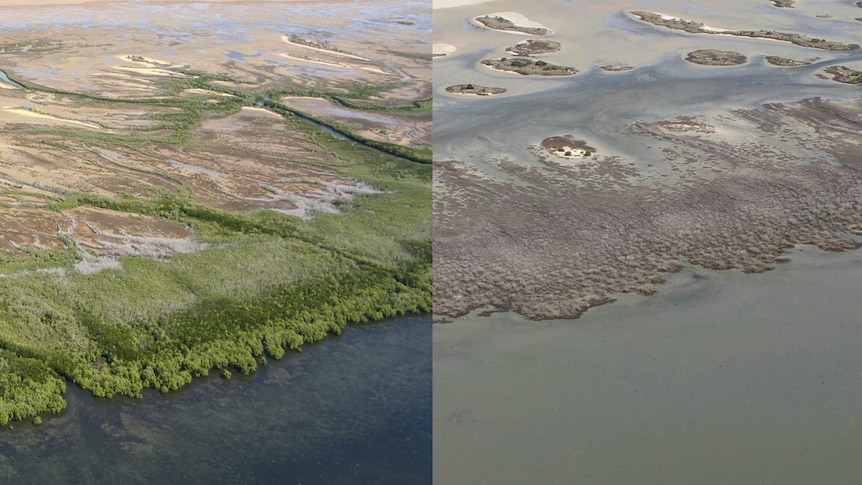In the summer of 2015-16, one of the most catastrophic mangrove diebacks ever recorded globally occurred in the Gulf of Carpentaria.
Key points:
- Low sea levels caused by severe El Niño events are thought to have caused the mass mangrove deaths
- Scientists say it is likely too late for the mangroves to recover
- A $30 million fishing industry is expected to be impacted
Some 40 million mangroves died across more than 2,000 kilometers of coastline, releasing nearly 1 million tonnes of carbon — equivalent to 1,000 jumbo jets flying back from Sydney to Paris.
After six years of searching for answers, scientists have formally identified what is causing the mass destruction. They hope the discovery will help predict and possibly prevent future events.
Valuable mangroves ‘died of thirst’
Mangrove ecologist and senior research scientist at James Cook University (JCU) Norman Duke was behind the discovery.
Dr Duke found that unusually low sea levels caused by severe El Niño events meant mangrove trees “essentially died of thirst”.
“The key factor responsible for this catastrophe appears to have been the sudden 40-centimetre drop in sea level that lasted for about six months, coinciding with no rainfall, killing vast areas of mangroves,” he said.
Author assisting with data analysis and JCU researcher Adam Canning said the study’s evidence for sea-level drop being the cause was found in the discovery of an earlier mass dieback in 1982, observed in satellite imagery.
“The 1982 dieback also coincided with an unusually extreme drop in sea level during another very severe El Niño event. We know from satellite data that the mangroves took at least 15 years to recover from that dieback,” Dr Canning said.
“Now they are caught in a vicious collapse and recovery cycle because of repeated pressure from climate change — the question remains when or if they will recover.”
Economic impact
Mangroves are valuable coastal ecosystems providing buffer shorelines against rising sea levels, protection against erosion, abundant carbon sinks, shelter for animals, nursery habitats, and food for marine life.
The destruction of mangroves can lead to a loss of fisheries, increased flooding, increased coastal damage from cyclones, and increased salinity of coastal soils and water supplies.
In the gulf, the mangrove dieback threatens a $30 million fishing industry, Dr Duke said.
“The fishing industry relies on these mangroves, including for redleg banana prawns, mudcrabs and fin fish,” he said.
“When the El Niño of 2015-16 struck, redleg banana prawn fishers reported their lowest-ever catches.”
Dr Duke said it was unlikely the gulf’s mangroves would recover due to the growing intensity of El Nino events.
“Our research reveals the presence of a previously unrecognized ‘collapse-recovery cycle’ of mangroves along gulf shorelines,” he said.
“The threat of future El Niño-driven sea level drops appears imminent, as evidence points to a link between climate change and severe El Niño and La Niña events.
“Indeed, El Niño and La Niña have become more deadly over the last 50 years, and the long-term damage they inflict is expected to escalate.
“Under these circumstances, the potential for the mangroves to recover is understandably low.
Protecting future ecosystems
Dr Duke said closer monitoring was key to preventing future mass diebacks. He said regular aerial surveys were a place to start.
“Tropical mangroves need much greater protection, and more effective maintenance with regular health checks from dedicated national shoreline monitoring,” he said.
“Our aerial surveys of more than 10,000 kilometers of north Australian coastlines have made a start.
“We’ve recorded environmental conditions and drivers of shoreline change for north-western Australia, eastern Cape York Peninsula, Torres Strait Islands and, of course, the Gulf of Carpentaria.
“As the climate continues to change, it’s vital to keep a close eye on our changing shoreline wetlands and to ensure we’re better prepared next time another El Niño disaster strikes.”
.
